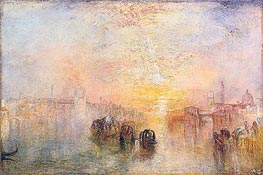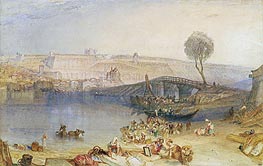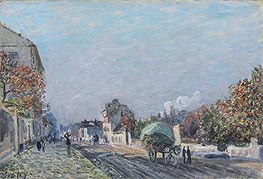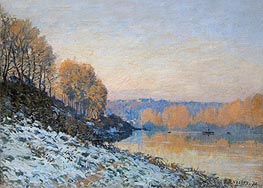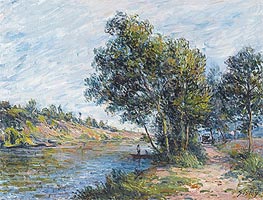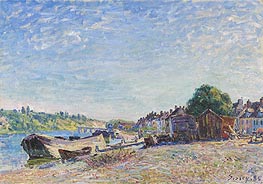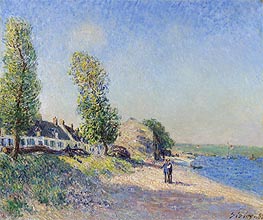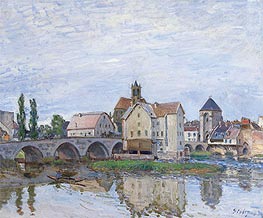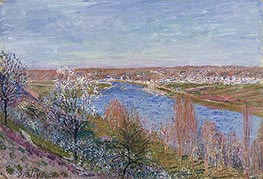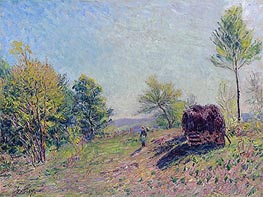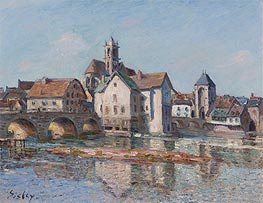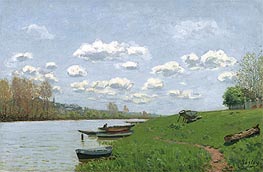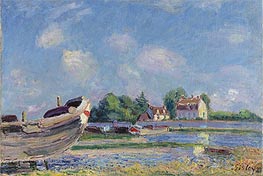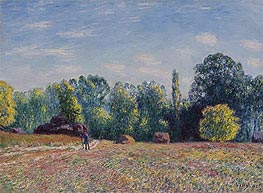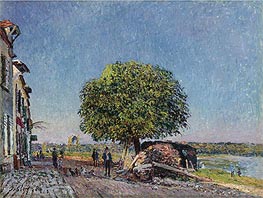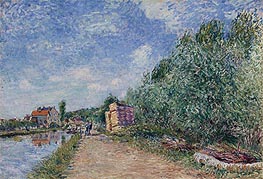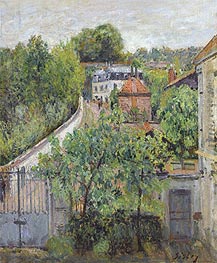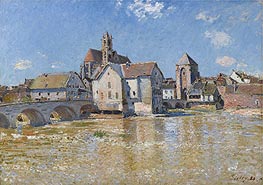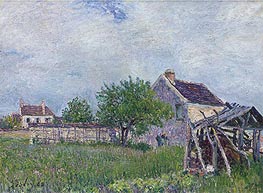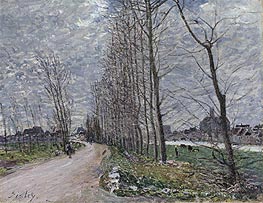Landscape Painting Reproductions - Page 84
Landscape painting is a genre of art that depicts outdoor scenes, such as mountains, forests, rivers, and gardens. The history of landscape painting dates back to ancient times, with examples from ancient Egyptian, Greek, and Roman art. During the Middle Ages, landscape paintings were mainly used as backgrounds for religious scenes, and it was not until the Renaissance that landscape painting emerged as a separate genre.
During the Renaissance, artists started to focus more on the natural world and began to experiment with perspective, light and shadow, and atmospheric effects in their landscapes. This period also saw the rise of topographical painting, which depicted accurate views of specific locations. During this time, artists such as Leonardo da Vinci and Albrecht Dürer produced iconic landscape paintings.
The 17th century Dutch Golden Age saw a trend towards landscapes that were more genre-like and less topographical, with scenes of everyday life and landscapes with rolling hills, waterways, and windmills. This period is also known for the development of the "Dutch light" style, which was characterized by a luminous, highly transparent quality of light and a preference for sunny skies. Painters such as Jan van Goyen and Jacob van Ruisdael became renowned for their realistic landscapes.
In the 18th and 19th centuries, Romanticism and the interest in the Sublime in art and literature led to a focus on dramatic, awe-inspiring landscapes. Painters such as J.M.W. Turner and Caspar David Friedrich used dramatic light, color, and form to evoke a sense of awe and drama in their landscapes.
The Impressionist movement of the late 19th century was characterized by its loose brushwork, light color palette, and emphasis on capturing the fleeting effects of light and atmosphere. Impressionist landscapes, such as those by Claude Monet and Pierre-Auguste Renoir, often depicted modern life, with leisurely scenes of parks, gardens, and the countryside.
Throughout the 20th century, landscape painting continued to evolve and diversify, with many artists pushing the boundaries of the genre through new styles and techniques. Some notable examples include the abstract landscapes of artists such as Mark Rothko and Joan Mitchell, and the photorealistic landscapes of Richard Estes and Ralph Goings.
Overall, landscape painting has a rich and varied history, reflecting the changing attitudes and perspectives of different cultures and time periods.
During the Renaissance, artists started to focus more on the natural world and began to experiment with perspective, light and shadow, and atmospheric effects in their landscapes. This period also saw the rise of topographical painting, which depicted accurate views of specific locations. During this time, artists such as Leonardo da Vinci and Albrecht Dürer produced iconic landscape paintings.
The 17th century Dutch Golden Age saw a trend towards landscapes that were more genre-like and less topographical, with scenes of everyday life and landscapes with rolling hills, waterways, and windmills. This period is also known for the development of the "Dutch light" style, which was characterized by a luminous, highly transparent quality of light and a preference for sunny skies. Painters such as Jan van Goyen and Jacob van Ruisdael became renowned for their realistic landscapes.
In the 18th and 19th centuries, Romanticism and the interest in the Sublime in art and literature led to a focus on dramatic, awe-inspiring landscapes. Painters such as J.M.W. Turner and Caspar David Friedrich used dramatic light, color, and form to evoke a sense of awe and drama in their landscapes.
The Impressionist movement of the late 19th century was characterized by its loose brushwork, light color palette, and emphasis on capturing the fleeting effects of light and atmosphere. Impressionist landscapes, such as those by Claude Monet and Pierre-Auguste Renoir, often depicted modern life, with leisurely scenes of parks, gardens, and the countryside.
Throughout the 20th century, landscape painting continued to evolve and diversify, with many artists pushing the boundaries of the genre through new styles and techniques. Some notable examples include the abstract landscapes of artists such as Mark Rothko and Joan Mitchell, and the photorealistic landscapes of Richard Estes and Ralph Goings.
Overall, landscape painting has a rich and varied history, reflecting the changing attitudes and perspectives of different cultures and time periods.
page 84 of 275
Going to the Ball (San Martino) 1846
Joseph Mallord William Turner
Oil Painting
$1037
$1037
Canvas Print
$49.42
$49.42
SKU: TJW-14394
Joseph Mallord William Turner
Original Size: 61.6 x 92.4 cm
Tate Gallery London United Kingdom
Joseph Mallord William Turner
Original Size: 61.6 x 92.4 cm
Tate Gallery London United Kingdom
SKU: TJW-14392
Joseph Mallord William Turner
Original Size: 29.9 x 45.7 cm
Louvre Museum Paris France
Joseph Mallord William Turner
Original Size: 29.9 x 45.7 cm
Louvre Museum Paris France
SKU: ASI-14391
Alfred Sisley
Original Size: unknown
Private Collection
Alfred Sisley
Original Size: unknown
Private Collection
SKU: ASI-14390
Alfred Sisley
Original Size: unknown
Musee des Beaux-Arts Lille France
Alfred Sisley
Original Size: unknown
Musee des Beaux-Arts Lille France
SKU: ASI-14389
Alfred Sisley
Original Size: 50 x 63 cm
Private Collection
Alfred Sisley
Original Size: 50 x 63 cm
Private Collection
SKU: ASI-14388
Alfred Sisley
Original Size: 38.7 x 56 cm
Private Collection
Alfred Sisley
Original Size: 38.7 x 56 cm
Private Collection
SKU: ASI-14387
Alfred Sisley
Original Size: 47.5 x 56.5 cm
Private Collection
Alfred Sisley
Original Size: 47.5 x 56.5 cm
Private Collection
SKU: ASI-14386
Alfred Sisley
Original Size: 60 x 73 cm
Private Collection
Alfred Sisley
Original Size: 60 x 73 cm
Private Collection
SKU: ASI-14385
Alfred Sisley
Original Size: 50 x 73 cm
Private Collection
Alfred Sisley
Original Size: 50 x 73 cm
Private Collection
SKU: ASI-14384
Alfred Sisley
Original Size: 54 x 73.6 cm
Private Collection
Alfred Sisley
Original Size: 54 x 73.6 cm
Private Collection
SKU: ASI-14383
Alfred Sisley
Original Size: 32.5 x 41.5 cm
Private Collection
Alfred Sisley
Original Size: 32.5 x 41.5 cm
Private Collection
SKU: ASI-14382
Alfred Sisley
Original Size: 54.5 x 73.5 cm
Private Collection
Alfred Sisley
Original Size: 54.5 x 73.5 cm
Private Collection
SKU: ASI-14381
Alfred Sisley
Original Size: 54 x 64 cm
Private Collection
Alfred Sisley
Original Size: 54 x 64 cm
Private Collection
SKU: ASI-14380
Alfred Sisley
Original Size: 46 x 65 cm
Private Collection
Alfred Sisley
Original Size: 46 x 65 cm
Private Collection
SKU: ASI-14379
Alfred Sisley
Original Size: 38.1 x 55.2 cm
Private Collection
Alfred Sisley
Original Size: 38.1 x 55.2 cm
Private Collection
SKU: ASI-14378
Alfred Sisley
Original Size: 60 x 81 cm
Private Collection
Alfred Sisley
Original Size: 60 x 81 cm
Private Collection
SKU: ASI-14377
Alfred Sisley
Original Size: 49.5 x 66.3 cm
Private Collection
Alfred Sisley
Original Size: 49.5 x 66.3 cm
Private Collection
SKU: ASI-14376
Alfred Sisley
Original Size: 50 x 73.5 cm
Private Collection
Alfred Sisley
Original Size: 50 x 73.5 cm
Private Collection
SKU: ASI-14375
Alfred Sisley
Original Size: 60 x 73 cm
Private Collection
Alfred Sisley
Original Size: 60 x 73 cm
Private Collection
SKU: ASI-14374
Alfred Sisley
Original Size: 46 x 38 cm
Private Collection
Alfred Sisley
Original Size: 46 x 38 cm
Private Collection
SKU: ASI-14373
Alfred Sisley
Original Size: 65 x 92 cm
Private Collection
Alfred Sisley
Original Size: 65 x 92 cm
Private Collection
SKU: ASI-14372
Alfred Sisley
Original Size: 46 x 55 cm
Private Collection
Alfred Sisley
Original Size: 46 x 55 cm
Private Collection
SKU: ASI-14371
Alfred Sisley
Original Size: 54 x 73 cm
Private Collection
Alfred Sisley
Original Size: 54 x 73 cm
Private Collection
SKU: ASI-14370
Alfred Sisley
Original Size: 50 x 65 cm
Private Collection
Alfred Sisley
Original Size: 50 x 65 cm
Private Collection
